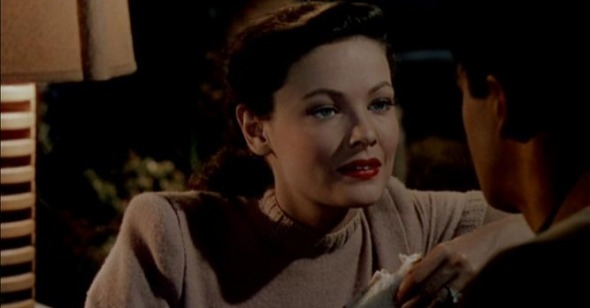The Bride Wore Black
Michael Koresky on Leave Her to Heaven
Despite Martin Scorsese propping it up with undying tenacity, John M. Stahl’s oft-touted 1945 "Technicolor noir," Leave Her to Heaven, still seems to languish on the peripheries of film history. When I cite it as a particularly juicy personal fave of forties Hollywood cinema, I’m usually met with a shrug or a quizzical stare. It’s then, when I try to reduce it to a jumble of words, that I realize that the movie’s pretty damn close to unclassifiable, even as all of its memorable moments are couched in some sort of basic generic playbook.
It takes almost an hour before we realize how deranged this tale truly is: the improbably stoic Ellen Berendt (played by the improbably gorgeous Gene Tierney) meets famed novelist Richard Harland (Cornel Wilde) on a train to New Mexico, and within five minutes worms her way into his life; as soon as he comes in contact with her porcelain stare he’s a goner, and his life proceeds to go to shambles. As devious as its irredeemable central character, Stahl’s stately misogynist melodrama barrels ahead with increasing absurdity, moving from romantic meet-cute to suspiciously manipulative behavior to all-out horror, finally culminating in a courtroom melodrama of such histrionic preposterousness that one can only throw one's hands up in frustration. Even by all-innuendos-considered post-Code Hollywood standards, rarely has a studio unleashed something so seemingly proper, so delicately laced with frilly curtains and gingham, which was so defiantly trashy at heart.
The brilliant azure skies, sparkling blue waves, and coarse Southwestern mountain ranges of the Oscar-winning on-location cinematography by Leon Shamroy—it's all exquisite, but perhaps nothing compares to the otherworldly visual effect that is Gene Tierney. With a simple arch of a plucked eyebrow or a barely perceptible parting of serpentine red lips, her seamlessly beautiful predator is a marvelous medusa; one glance into the camera is enough to stop a heart from beating. Having played the enigmatic, nearly resurrected "Laura" only a year prior, Tierney carries some added intertextual noir heft to her role. Whether scattering her perhaps-a tad-too-beloved father’s ashes around the a canyon at dawn or pregnant, creeping around her nursery as though she’s surveying a garbage dump, Tierney’s Ellen is not of this earth; she’s more than a human fluke, almost a cosmic joke.
Where Leave Her to Heaven stands alone is in its forthrightly alienating tactics—there’s nary an attempt to truly psychoanalyze this monster; we simply watch, as impotently as her husband, as she drags down everyone along with her. In a sense it’s even ballsier than Psycho: as ironic as Hitchcock’s closing diagnostic session was, that film still provided enough of a Freudian groundswell to contain its irrationality. Ellen’s vindictive and vile machinations seem to spring almost out of nowhere, and are frighteningly accepted with a casual, distrustful air by her comparatively well-adjusted family. “There's nothing wrong with Ellen. It's just that she loves too much,” says her mother, prompting viewers’ foreheads to crease. That’s about as much backstory as we get—yet with Cornel Wilde’s cowardly resignation as off-putting as Tierney’s cunning debauchery, Ellen remains our amoral compass. And she’s unfathomable right to the end, even beyond the grave.
A noir without shadows? A women’s picture that posits its female protagonist as a ravenous, sociopathic schemer? A high body-count thriller in which not one drop of blood is spilled? Leave Her to Heaven doesn’t ultimately defy categorization so much as confound easy readings of classical Hollywood approach. Even in setting, Stahl’s film retreats from convention; its exquisite location shooting, spanning from New Mexico to Maine, provides glorious, sunlit counterpoint to the femme-fatale trickery: by unleashing its monster onto these open vistas as opposed to the shadowy urban backrooms and backlot alleyways usually trod by her ilk, the film provides an air of false reassurance; when the nefarious deeds kick into high gear, you can only suck in your breath in astonishment.
To this day the infamous central murder scene never fails to disturb: Richard’s adoring younger brother, Danny (played by Darryl Hickman), a “gosh-darn” jolly preteen saddled with an illness that leaves him mostly paralyzed from the waist down, checks out of the hospital to move back with his brother and his gorgeous new bride. Jealous of the boy’s ability to monopolize her husband’s attention, Ellen exacts a horrific revenge on the crippled kid, coolly watching him drown while supervising one of his therapeutic swimming sessions in a secluded lake. Much has been made of the scene, played without musical accompaniment, shot with the serene drift of a calm riverboat trip downstream; Scorsese even included it in his Personal Journey Through American Movies. Armed with nothing more than a pair of diabolical sunglasses and a smart blouse, Gene Tierney uses her narcissistic glower to perfection, creating a heart-stopping moment to compare with Carl Boehm’s ontological slaughter in Peeping Tom and Richard Widmark’s stairway-to-heaven shove in Kiss of Death. Silent and merciless, Ellen’s becalmed tyranny makes for some of American film’s most truly disquieting moments.
Leave Her to Heaven played May 12 as part of Reverse Shot's See It Big series at Museum of the Moving Image.
